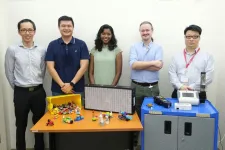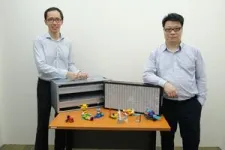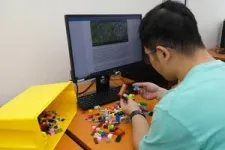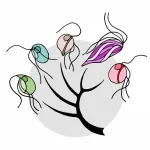Working with the global air filter manufacturer Camfil on a shared research project, the NTU Singapore scientists found in a study that high levels of volatile organic compounds – gases released from products such as detergents, pesticides, perfumes, aerosol sprays and paint – affected the study participants’ creativity when they were asked to build 3D models with LEGO bricks.
Using a statistical analysis, the NTU team estimated that reducing total volatile organic compounds (TVOC) by 72 per cent could improve a student’s creative potential by 12 per cent.
TVOC is an indicator that refers to the volume of volatile organic compounds in the air. Indoor VOCs are emitted from interior decoration sources such as paints and carpets and household products such as detergents and air fresheners.
This study, conducted on the NTU Smart Campus, is part of a partnership between the University and Camfil to investigate the impact of indoor air quality on the cognitive performance of adults, test various air filter technologies in tropical weather conditions, and deliver innovative clean air solutions combined with optimised energy efficiency.
The findings detailed in the study, published in Scientific Reports in September, shed light on the importance of indoor air quality on our creative cognition, said the research team led by Assistant Professor Ng Bing Feng and Associate Professor Wan Man Pun, Cluster Directors for Smart & Sustainable Building Technologies at the Energy Research Institute @ NTU (ERI@N).
Asst Prof Ng said: “While most people would correctly associate indoor air quality with effects on the lungs, especially since we just emerged from a pandemic, our study shows that it could also have an impact on the mind and creative cognition, or the ability to use knowledge in an unconventional way. Our findings suggest that relatively low TVOC levels, even if well within the accepted threshold, could impact an individual’s creative potential.”
Assoc Prof Wan added: “This could have serious consequences for industries that rely on creativity for the bulk of their work. For instance, artists often use paints and thinners that release high levels of volatile organic compounds and may not know they need adequate ventilation to clear them from their workplace. The findings also point to how making minor adjustments in the office, such as reducing the use of aroma diffusers or ensuring adequate ventilation, could positively impact employees and their productivity.”
The study also aligns with the Health & Society and Brain & Learning research clusters under the research pillar of NTU 2025, the University’s five-year strategic plan.
The other scientists on the research team were NTU PhD graduate Dr Shmitha Arikrishnan, former NTU senior research fellow Dr Adam Charles Robert, who is currently a postdoctoral researcher at Singapore-ETH Centre, and NTU graduate Lau Wee Siang.
Assessing creativity through LEGO 3D models
To quantifiably assess creative potential in this study, the NTU team developed the Serious Brick Play method, which is largely adapted from the LEGO Serious Play framework. This tool involves expressing thoughts and ideas using 3D models built with LEGO bricks.
A typical LEGO Serious Play session involves a facilitator who introduces a challenge, to which participants respond by building a model using LEGO bricks. Participants then discuss their models and reflect on the building process, prompted by the facilitator.
In the Serious Brick Play method designed by the NTU team, participants do not discuss their models and share their reflections in a group. Instead, they provide written descriptions of their LEGO models. These written descriptions and LEGO models are then scored by a panel of judges for creativity.
Asst Prof Ng explained: “While the LEGO Serious Play framework has been used in various settings to unleash creative thinking and has even been used to support dementia patients, it does not have a quantitative assessment component and cannot systematically assess creativity. This is why we added a component to score participants on their creativity.”
The scoring guidelines for the participants’ LEGO models were developed based on the Creative Product Analysis Matrix model, which is used to grade creativity and has been validated in earlier studies, he added.
The NTU researchers tested the scoring guidelines to measure the degree of consistency among the different judges when they independently assessed the LEGO models, and concluded that the scoring guidelines provided were reliable.
The researchers also tested the Serious Brick Play method’s ability to measure what it was designed for through statistical analyses and found that the method was able to cover the key aspects of the Alternative Uses Task, a well-known tool that assesses creativity. Specifically, it assesses divergent thinking, a thought process used to generate creative ideas by exploring many possible solutions.
The researchers said that the Serious Brick Play method further assesses another thought process called convergent thinking, which focuses on coming up with a single, well-established answer to a problem.
“Divergent and convergent thinking are thought to be the central components of creativity, but most existing tools are designed around divergent thinking. Our Serious Brick Play method adds value by also covering the aspect of convergent thinking,” said Asst Prof Ng.
How the study was done
Over six weeks, the researchers gathered data from a sample size of 87 undergraduate and postgraduate students in a controlled environment simulating an indoor workspace. Every week across three 40-minute sessions, the study participants read a summary of a global issue – such as climate change, mental health, and poverty – and then offered a solution by building a 3D model using LEGO bricks. The participants were then asked to give a written description and explanation for their models.
In each session, researchers varied the air quality of the workspace using different combinations of air filters contributed by Camfil. This varied the level of pollutants in the air, including carbon dioxide, PM2.5 (air pollutants less than 2.5 micrometres in diameter), and total volatile organic compounds (TVOC).
The participants’ LEGO models and descriptions were then graded by seven randomly selected adults, who were trained to familiarise themselves with the scoring guidelines based on:
Originality: whether the solution is usual or unusual,
Fluency: the level of elaboration in the description of the solution, and
Build: how sophisticated, complex, or aesthetic the solution is.
Link between TVOC levels and creativity
The NTU team’s statistical analysis of the participants’ average scores and indoor air quality data gathered from 18 sessions revealed that participants tended to turn in creative solutions with lower scores – an indicator of lower creative potential – when the workspace had higher TVOC levels.
Using a statistical model, the team calculated that reducing TVOC from an acceptable threshold[1] of 1,000 parts per billion to 281 parts per billion – or a 72 per cent reduction in TVOC levels – led to a 12 per cent increase in creative potential in the study cohort.
Less significant relationships were found between PM2.5 and creativity as well as carbon dioxide levels and creativity.
Asst Prof Ng said: “The results from this study indicate that creativity levels can be linked to the concentration of pollutants in a room. Improving the air quality could be an economical solution to improve occupants’ creativity.”
Having uncovered a link between TVOC levels and creativity, the research team is now studying how TVOC and other indoor air pollutants affect cognitive processes by measuring participants’ brain activity.
***END***
[1] According to the Singapore Standards SS554 Code of Practice for indoor air quality for airconditioned buildings, the total volatile organic compounds should be less than or equal to 1,000 parts per billion.
END





